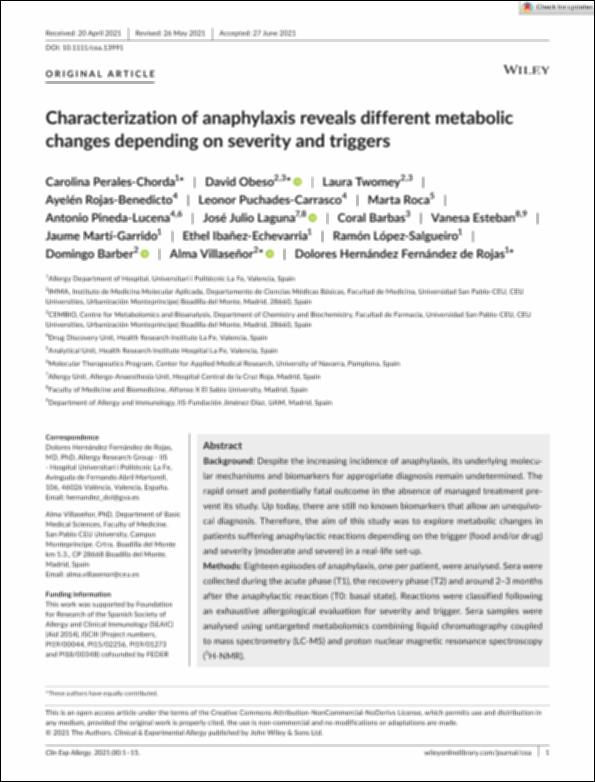Please use this identifier to cite or link to this item:
http://hdl.handle.net/10637/12974Characterization of anaphylaxis reveals different metabolic changes depending on severity and triggers.
| Title: | Characterization of anaphylaxis reveals different metabolic changes depending on severity and triggers. |
| Authors : | Perales Chorda, Carolina Obeso Montero, David Barber Hernández, Domingo Villaseñor Solis, Alma Cristina Barbas Arribas, Coral. Twomey, Laura Rojas-Benedicto, Ayelén |
| Keywords: | Alergia a los alimentos.; H-NMR; Drug anaphylaxis; Food anaphylaxis; Grading anaphylaxis; IgE-mediated anaphylaxis; Untargeted metabolomics; UPLC-MS |
| Abstract: | Background: Despite the increasing incidence of anaphylaxis, its underlying molecular mechanisms and biomarkers for appropriate diagnosis remain undetermined. The rapid onset and potentially fatal outcome in the absence of managed treatment prevent its study. Up today, there are still no known biomarkers that allow an unequivocal diagnosis. Therefore, the aim of this study was to explore metabolic changes in patients suffering anaphylactic reactions depending on the trigger (food and/or drug) and severity (moderate and severe) in a real-life set-up. Methods: Eighteen episodes of anaphylaxis, one per patient, were analysed. Sera were collected during the acute phase (T1), the recovery phase (T2) and around 2–3 months after the anaphylactic reaction (T0: basal state). Reactions were classified following an exhaustive allergological evaluation for severity and trigger. Sera samples were analysed using untargeted metabolomics combining liquid chromatography coupled to mass spectrometry (LC-MS) and proton nuclear magnetic resonance spectroscopy (1 H-NMR). Results: ‘Food T1 vs T2’ and ‘moderate T1 vs T2’ anaphylaxis comparisons showed clear metabolic patterns during the onset of an anaphylactic reaction, which differed from those induced by drugs, food + drug or severe anaphylaxis. Moreover, the model of food anaphylaxis was able to distinguish the well-characterized IgE (antibiotics) from non-IgE-mediated anaphylaxis (nonsteroidal anti-inflammatory drugs), suggesting a differential metabolic pathway associated with the mechanism of action. Metabolic differences between ‘moderate vs severe’ at the acute phase T1 and at basal state T0 were studied. Among the altered metabolites, glucose, lipids, cortisol, betaine and oleamide were observed altered. Conclusions: The results of this exploratory study provide the first evidence that different anaphylactic triggers or severity induce differential metabolic changes along time or at specific time-point, respectively. Besides, the basal status T0 might identify high-risk patients, thus opening new ways to understand, diagnose and treat anaphylaxis. |
| Description: | En: Clinical & Experimental Allergy. e-ISSN 1365-2222 2021, 26 Jul : 1-15 |
| URI: | http://hdl.handle.net/10637/12974 |
| Rights : | http://creativecommons.org/licenses/by-nc-nd/4.0/deed.es |
| Issue Date: | 8-Sep-2021 |
| Center : | Universidad San Pablo-CEU |
| Appears in Collections: | Facultad de Farmacia |
Items in DSpace are protected by copyright, with all rights reserved, unless otherwise indicated.


